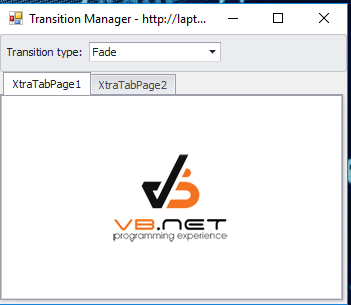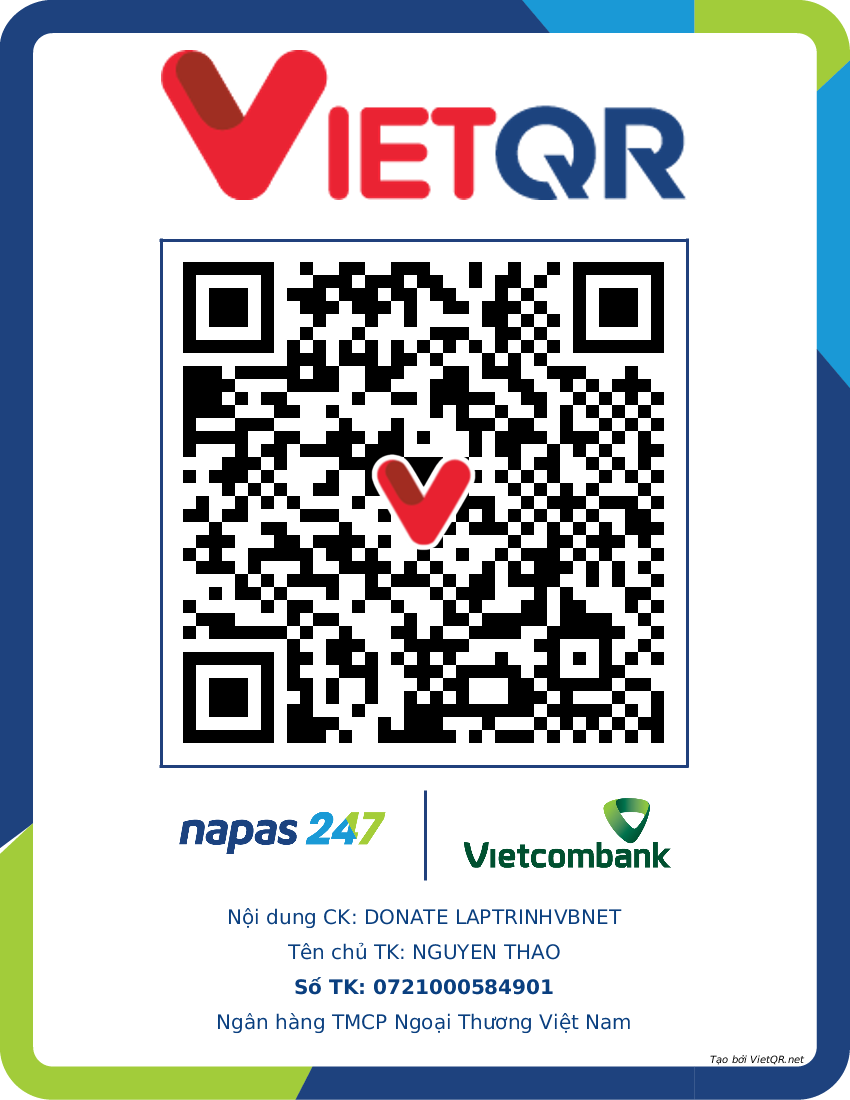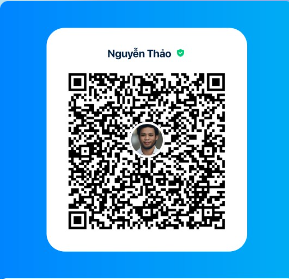- [DEVEXPRESS] Chia sل؛» code cأ،c tل؛،o report in nhiل»پu hأ³a ؤ‘ئ،n trأھn XtraReport C#
- [POWER AUTOMATE] Hئ°ل»›ng dل؛«n gل»ںi tin nhل؛¯n zalo tل»« file Excel - No code
- [C#] Chia sل؛» code lock vأ unlock user trong domain Window
- [SOFTWARE] Giل»›i thiل»‡u bل»™ phل؛§n mل»پm tأnh Kل؛؟t Cل؛¥u Thأ©p HatteSale, Mل»™ng ؤگئ،n, Dل؛§m, Sأ n, Mأ³ng Cل»چc, Vأ،ch, Xأ Gل»“, Tأnh Tل؛£i Trل»چng
- [DEVEXPRESS] Vل؛½ Biل»ƒu ؤگل»“ Stock Chل»©ng Khoأ،n - Cأ´ng Cل»¥ Thiل؛؟t Yل؛؟u Cho Nhأ ؤگل؛§u Tئ° trأھn Winform
- [C#] Hئ°ل»›ng dل؛«n bل؛£o mل؛t ل»©ng dل»¥ng 2FA (Multi-factor Authentication) trأھn Winform
- [C#] Hئ°ل»›ng dل؛«n convert HTML code sang PDF File trأھn NetCore 7 Winform
- [C#] Hئ°ل»›ng dل؛«n viل؛؟t ل»©ng dل»¥ng chat vل»›i Gemini AI Google Winform
- Hئ°ل»›ng dل؛«n khأ³a file bل؛±ng nhiل»پu process id, khأ´ng cho xأ³a tل؛p tin
- Hئ°ل»›ng dل؛«n cأ،ch tل؛،o Product Id cho ل»©ng dل»¥ng phل؛§n mل»پm XXXXX-XXXXX-XXXXX-XXXXX
- [SQLSERVER] Hئ°ل»›ng dل؛«n tل؛،o script sql tل»« ل»©ng dل»¥ng Sqlserver management Studio
- [C#] Hئ°ل»›ng dل؛«n sل» dل»¥ng thئ° viل»‡n AutoITx lل؛¥y id vأ password Ultraviewer trأھn winform
- [VB.NET] Hئ°ل»›ng dل؛«n lل؛¥y thأ´ng tin tأ i khoل؛£n ؤ‘ؤƒng nhل؛p windows vأ khل»ںi ؤ‘ل»™ng lل؛،i ل»©ng dل»¥ng ل»ں chل؛؟ ؤ‘ل»™ Administrator
- [C#] Sل» dل»¥ng thئ° viل»‡n Polly gل»i lل؛،i request api khi request bل»‹ lل»—i hay rل»›t mل؛،ng
- [DEVEXPRESS] Chia sل؛» source code tل؛،o bأ،o cأ،o report in tem nhأ£n label trأھn C# winform
- [DEVEXPRESS] Hئ°ل»›ng dل؛«n vل؛½ biل»ƒu ؤ‘ل»“ Bar Chart trأھn Winform
- [C#] Tل؛،o form ؤ‘ؤƒng nhل؛p vأ ؤ‘ؤƒng kأ½ vل»›i hiل»‡u ل»©ng Sliding Animation Effect
- [C#] Hئ°ل»›ng dل؛«n tل؛،o thanh toأ،n ؤ‘ئ،n hأ ng qua mأ£ vل؛،ch VietQR sل» dل»¥ng API PayOS hoأ n toأ n miل»…n phأ
- [C#] Hئ°ل»›ng dل؛«n ghi log ra RichTextBox giل»‘ng Console trأھn Winform sل» dل»¥ng thئ° viل»‡n Serilog
- [C#] Hئ°ل»›ng dل؛«n cأ،ch tل؛،o mأ£ QR Code trأھn file Excel
[DEVEXPRESS] Hئ°ل»›ng dل؛«n tل؛،o hiل»‡u ل»©ng di chuyل»ƒn qua lل؛،i cأ،c tab sل» dل»¥ng Transition Manager
Hأ´m nay, mأ¬nh xin hئ°ل»›ng dل؛«n cأ،c bل؛،n tل؛،o hiل»‡u ل»©ng, khi di chuyل»ƒn qua lل؛،i giل»¯a cأ،c tab sل» dل»¥ng Transition Manager trong bل»™ cأ´ng cل»¥ Devexpress.
Transition Manger cung cل؛¥p cho chأ؛ng ta rل؛¥t nhiل»پu hiل»‡u ل»©ng bao gل»“m: Fade, clock, Dissolve, Shape, SlideFade, Cover, Comb.
Giao diل»‡n chئ°ئ،ng trأ¬nh:آ

Video Demo :
Source code cho ل»©ng dل»¥ng:
Imports DevExpress.Utils.Animation
Imports DevExpress.XtraEditors
Public Class Form1
Dim animatedControl As Control
Private Sub Form1_Load(sender As Object, e As EventArgs) Handles MyBase.Load
animatedControl = XtraTabControl1
' Populate the ImageComboBox with available transition types.
ImageComboBoxEdit1.Properties.Items.AddEnum(GetType(DevExpress.Utils.Animation.Transitions))
AddHandler ImageComboBoxEdit1.SelectedIndexChanged, AddressOf ImageComboBoxEdit1_SelectedIndexChanged
ImageComboBoxEdit1.SelectedIndex = 0
End Sub
Private Sub ImageComboBoxEdit1_SelectedIndexChanged(sender As Object, e As EventArgs)
Dim imComboBox As ImageComboBoxEdit = TryCast(sender, ImageComboBoxEdit)
If TransitionManager1.Transitions(animatedControl) Is Nothing Then
' Add a transition, associated with the xtraTabControl1, to the TransitionManager.
Dim transition1 As New Transition()
transition1.Control = animatedControl
TransitionManager1.Transitions.Add(transition1)
End If
' Specify the transition type.
Dim trType As DevExpress.Utils.Animation.Transitions = DirectCast(imComboBox.EditValue, DevExpress.Utils.Animation.Transitions)
TransitionManager1.Transitions(animatedControl).TransitionType = CreateTransitionInstance(trType)
End Sub
Private Function CreateTransitionInstance(transitionType As Transitions) As BaseTransition
Select Case transitionType
Case Transitions.Dissolve
Return New DissolveTransition()
Case Transitions.Fade
Return New FadeTransition()
Case Transitions.Shape
Return New ShapeTransition()
Case Transitions.Clock
Return New ClockTransition()
Case Transitions.SlideFade
Return New SlideFadeTransition()
Case Transitions.Cover
Return New CoverTransition()
Case Transitions.Comb
Return New CombTransition()
Case Else
Return New PushTransition()
End Select
End Function
Private Sub XtraTabControl1_SelectedPageChanging(sender As Object, e As DevExpress.XtraTab.TabPageChangingEventArgs) Handles XtraTabControl1.SelectedPageChanging
' Start the state transition when a page is about to be switched.
If animatedControl Is Nothing Then
Return
End If
TransitionManager1.StartTransition(animatedControl)
End Sub
Private Sub XtraTabControl1_SelectedPageChanged(sender As Object, e As DevExpress.XtraTab.TabPageChangedEventArgs) Handles XtraTabControl1.SelectedPageChanged
' Finish the transition after a page has been selected.
TransitionManager1.EndTransition()
End Sub
' A custom easing function.
Dim myEasingFunc As DevExpress.Data.Utils.IEasingFunction = New DevExpress.Data.Utils.BackEase()
Private Sub TransitionManager1_CustomTransition(transition As DevExpress.Utils.Animation.ITransition, e As DevExpress.Utils.Animation.CustomTransitionEventArgs) Handles TransitionManager1.CustomTransition
' Set a clip region for the state transition.
e.Regions = New Rectangle() {XtraTabPage1.Bounds}
' Specify a custom easing function.
e.EasingFunction = myEasingFunc
End Sub
End ClassSource code sل» dل»¥ng C#
using System;
using System.Collections.Generic;
using System.ComponentModel;
using System.Data;
using System.Drawing;
using System.Linq;
using System.Text;
using System.Windows.Forms;
using DevExpress.Utils.Animation;
using DevExpress.XtraEditors;
using DevExpress.XtraEditors.Controls;
namespace TransitionManagerSample {
public partial class Form1 : Form {
public Form1() {
InitializeComponent();
}
Control animatedControl;
private void xtraTabControl1_SelectedPageChanging(object sender, DevExpress.XtraTab.TabPageChangingEventArgs e) {
// Start the state transition when a page is about to be switched.
if (animatedControl == null) return;
transitionManager1.StartTransition(animatedControl);
}
private void xtraTabControl1_SelectedPageChanged(object sender, DevExpress.XtraTab.TabPageChangedEventArgs e) {
// Finish the transition after a page has been selected.
transitionManager1.EndTransition();
}
private void Form1_Load(object sender, EventArgs e) {
animatedControl = xtraTabControl1;
// Populate the ImageComboBox with available transition types.
imageComboBoxEdit1.Properties.Items.AddEnum(typeof(DevExpress.Utils.Animation.Transitions));
imageComboBoxEdit1.SelectedIndexChanged += imageComboBoxEdit1_SelectedIndexChanged;
imageComboBoxEdit1.SelectedIndex = 0;
}
BaseTransition CreateTransitionInstance(Transitions transitionType) {
switch (transitionType) {
case Transitions.Dissolve: return new DissolveTransition();
case Transitions.Fade: return new FadeTransition();
case Transitions.Shape: return new ShapeTransition();
case Transitions.Clock: return new ClockTransition();
case Transitions.SlideFade: return new SlideFadeTransition();
case Transitions.Cover: return new CoverTransition();
case Transitions.Comb: return new CombTransition();
default: return new PushTransition();
}
}
void imageComboBoxEdit1_SelectedIndexChanged(object sender, EventArgs e) {
ImageComboBoxEdit imComboBox = sender as ImageComboBoxEdit;
if (transitionManager1.Transitions[animatedControl] == null) {
// Add a transition, associated with the xtraTabControl1, to the TransitionManager.
Transition transition1 = new Transition();
transition1.Control = animatedControl;
transitionManager1.Transitions.Add(transition1);
}
// Specify the transition type.
DevExpress.Utils.Animation.Transitions trType = (DevExpress.Utils.Animation.Transitions)imComboBox.EditValue;
transitionManager1.Transitions[animatedControl].TransitionType = CreateTransitionInstance(trType);
}
// A custom easing function.
DevExpress.Data.Utils.IEasingFunction myEasingFunc = new DevExpress.Data.Utils.BackEase();
private void transitionManager1_CustomTransition(DevExpress.Utils.Animation.ITransition transition, DevExpress.Utils.Animation.CustomTransitionEventArgs e) {
// Set a clip region for the state transition.
e.Regions = new Rectangle[] { xtraTabPage1.Bounds };
// Specify a custom easing function.
e.EasingFunction = myEasingFunc;
}
}
}Chأ؛c cأ،c bل؛،n thأ nh cأ´ng. Mل»چi cأ¢u hل»ڈi thل؛¯c mل؛¯c ؤ‘ل؛؟n bأ i viل؛؟t xin truy cل؛pآ http://hoidap.laptrinhvb.netآ ؤ‘ل»ƒ ؤ‘ئ°ل»£c support.
ؤگل»ھNG QUأٹN LIKE AND SHARE NHA CأپC Bل؛ N.آ
CأپM ئ N CأپC Bل؛ N ؤگأƒ THEO Dأ•I.



 آ آ آ آ
آ آ آ آ 


